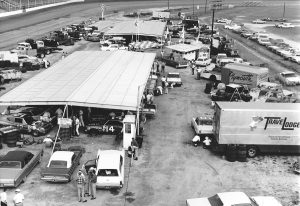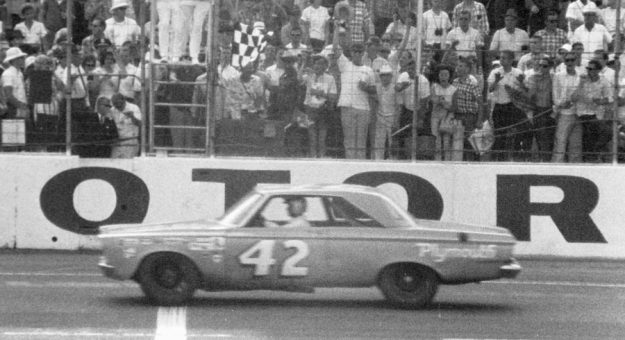Editor’s Note: NASCAR is celebrating its 75th anniversary in 2023. SPEED SPORT was founded in 1934 and was already on its way to becoming America’s Motorsports Authority when NASCAR was formed. As a result, we will bring you Part 19 of a 75-part series on the history of NASCAR as told in the pages of National Speed Sport News and SPEED SPORT Magazine.
Ford began 1966 planning to use a 427-cubic-inch “lo-rise” engine after its single-overhead cam engine was deemed “strictly racing” by NASCAR. Undeterred, Dan Gurney gunned a Ford with a “lo-rise” powerplant to his fourth consecutive victory in the Motor Trend 500 road race at Riverside.
One month later, Ford pilot Dick Hutcherson set fast time in the second of two 100-mile Daytona 500 qualifying races before he won the Bristol, Tenn., 250-miler in March. April saw Fords grab the pole in three consecutive races, but then the black flag waved on Ford’s season.
NASCAR approved Ford’s single-overhead cam engine, but with an adjoiner which put Ford at a weight disadvantage.

The new rules dictated that cars using the SOHC engine must weigh at least 10.36 pounds per cubic inch as compared to the 9.36 pounds for all other units. This effectively put Ford at a 400-pound disadvantage versus Chrysler cars and pushed the car maker to retire from NASCAR after a five-year stint.
In a reversal of roles, Chrysler drivers now found themselves with little competition from disadvantaged Ford pilots. On the season, Plymouths and Dodges won 33 of the 49 races, with 13 falling to Ford pilots and three to Chevrolet owners.
David Pearson led the Chrysler stampede in Cotton Owens’ 1966 Dodge Charger. The 1960 rookie of the year did not start seven races, but led 3,174 laps on the way to a division-leading 15 victories and 33 top-10 finishes.
Rookie-of-the-year James Hylton, the former crew chief for Ned Jarrett, pushed Pearson all season, but ended second in the points. Richard Petty returned to full-time NASCAR competition and grabbed 16 poles and eight victories while earning $94,666 to lead the series.
Fuel cells were in development prior to Fireball Roberts’ death in 1964, but were rot mandatory in NASCAR Grand National cars. The fuel cell was described in NSSN as a rubberized gas tank filled with foam baffle and covered with a layer of Vithane-flexible coating, which held the fuel in the event of a fuel tank rupture. NASCAR mandated fuel cells in all cars effective Sept. 1, 1966.
Don MacTavish won the late model sportsman title, while Ernie Gahan was the modified champion.
